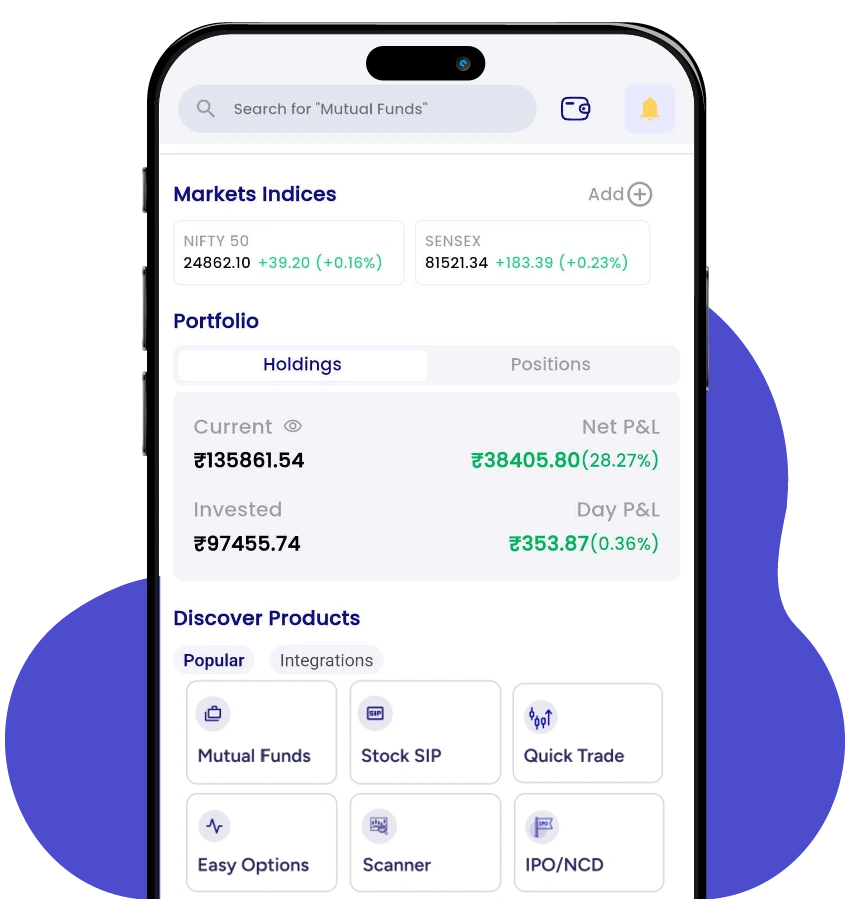What is Implied Volatility?
- 21st July 2025
- 10:30 AM
- 7 min read
As an options trader, you must have come across the term implied volatility or IV, but have you ever wondered what it is and why it is important for you?
It is important as it shows how volatile a market can be in the future. It also helps you to calculate the probability of a market being favourable or unfavourable for you.
If you take an example of the recent average volatility of Nifty 50 options, you will see it ranges between 13.5% and 15.5%, indicating a low volatility. Read this blog to learn about this volatility, its pros and cons and more.
What Does Implied Volatility in Option Trading Denote?
When discussing implied volatility meaning, you must know that it is a tool to represent the anticipated volatility of stocks until an option reaches its expiry date.
To put it simply, the demand for an option and the market’s expectation about future price movement of the underlying assets in an option shape the implied volatility.
Therefore, IV increases if the market demand for an option increases and the cost of an option increases. Conversely, IV decreases if the demand decreases with the price of the option.
For example, suppose the cost of a stock in an option is currently INR 200, and it increases to INR 230 as demand increases. This is beneficial for you as an option owner. However, if demand drops and the price becomes INR 170, IV falls. Then, it becomes favourable for you as an option seller.
Significance of Implied Volatility as a Trading Tool
Here are some facts about implied volatility in options trading that you should know:
- Investors like you consider implied volatility as a tool for trading, as it provides them with practical insight into whether an asset price will change moderately, slightly or largely.
- From buying an option till its expiry, as an option trader, you can use the IV to calculate the probable price range of an underlying asset.
- Using an IV index, you can also get insights into upcoming fluctuations in the prices of underlying assets. This is suitable for locating entry and exit points in and out of a trade.
- IV helps weigh risk against rewards. For example, if you purchase an option of INR 100 with an anticipated move of only INR 50, this reward is not worth the risk. However, if the price movement is INR 100, this trade might be worth the risk and favourable.
How is Implied Volatility Interpreted in Options Trading?
Here is how investors interpret the implied volatility in options trading:
- Although the IV cannot predict whether the market will go upward or downward, traders consider a higher IV as an indication of a bearish market. For example, if the IV of an underlying asset rises from 25% to 45%, investors often link this rise with a price drop and buy put options to protect their investments.
- An IV usually drops when investors do not heavily hedge to deal with market shifts. Most Indian traders prefer the IV to be between 20% and 25%. Also, the recent at-the-money NIFTY 50 option shows an IV of up to 13.55%. This indicates that investors do not expect sharp price changes shortly.
- When you opt to buy an option, the premium is determined based on the expected market volatility. Also, in markets with lower liquidity, counterparties negotiate based on the IV instead of the actual option price.
You can trade in derivatives, equities, mutual funds and more and increase your return potential with PL Capital Group – Prabhudas Lilladher. Download the PL Capital app and make your investment journey smoother.
Advantages and Limitations of Implied Volatility
Now that you have an idea about implied volatility in options, let us explore some of its pros and cons:
- It acts as an accurate and reliable tool for forecasting future prices of the underlying assets of an option. Thus, it becomes essential to predict and determine the derivative pricing during options trading.
- IV as a trading tool also considers market insights, investors’ sentiment, etc. For example, recently, the Indian equity market experienced a significant surge as 10.1 lakh new investors joined. This highlights the positive investor sentiment and helps you to invest accordingly.
- Although the implied volatility can indicate the potential price fluctuations in the future, it cannot clarify the direction of market movement.
- When you use IV for option trading, it solely focuses on the price movement. However, it ignores other crucial factors such as PEG ratio, P/E ratio and EPS or Earnings Per Share.
How Implied Volatility Differs from Historical Volatility?
As it is clear what is implied volatility, let us differentiate it from historical volatility:
| Parameters | Implied Volatility | Historical Volatility |
| Short definition | It helps predict future price movements based on the current market expectations. | It considers past price fluctuations or movement over a certain time frame. |
| Influencing factors | Economic events, market sentiment and demand for options affect IV. | Historical investment trends, trading volume and price changes in the past affect it. |
| Impact on options | A high IV increases the cost of premiums, increasing the overall option cost. A lower IV makes an option cheaper. | It helps assess risks in the past, but it does not impact the current option pricing. |
Conclusion
Implied volatility provides you with a forecast about the movement or fluctuation in the pricing of underlying assets in an option. It can forecast how much the price will fluctuate, but it cannot decide whether the market value of the assets will go up or down exactly. As an options trader, you can refer to the IV and determine when to buy or sell an option.
With PL, you can invest in derivatives, stocks, mutual funds and more, and diversify your portfolio. Download the PL Capital app today!
FAQ’s
1. What are high IV stocks?
A stock with a higher IV is an indication that there is a significant price movement of the stock in the next 12 months. This also indicates a bearish market sentiment, and investors usually opt to put options in such a scenario. This helps to limit investment losses.
2. Is high implied volatility beneficial or harmful?
If the IV goes higher for a stock, for example, the option becomes pricier. This is good for option buyers as they can now purchase assets at a predetermined and lower cost. However, for option sellers, it offers a high premium but also comes with a risk of losses in case the price moves sharply.
3. How do you calculate implied volatility?
To calculate the IV, you must input the price of the option into the algorithm known as Black-Scholes. Also, iterative search is another option to calculate the IV.





